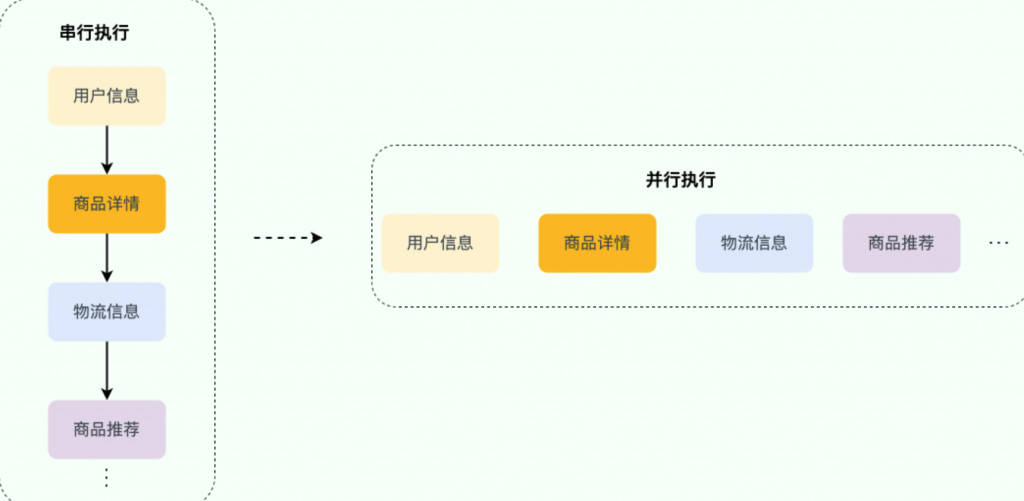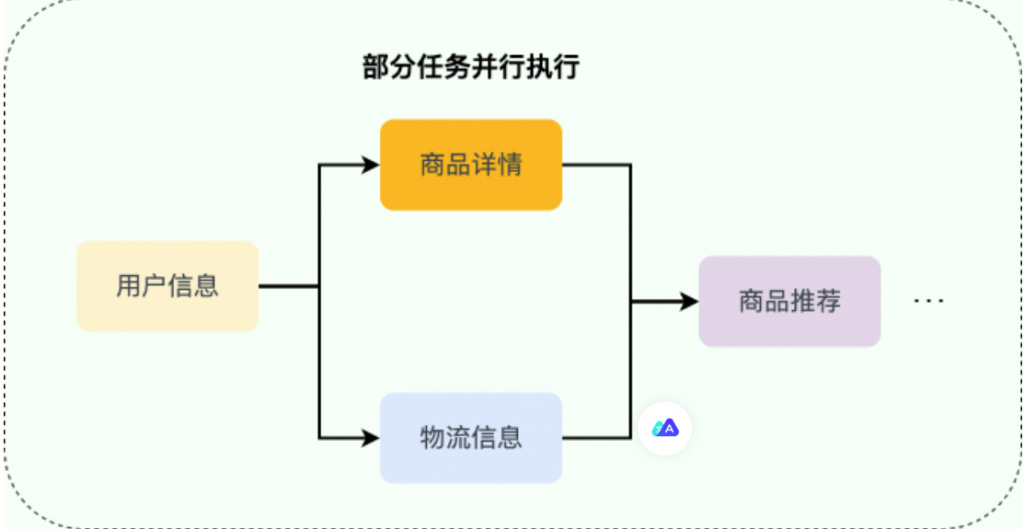CompletableFuture 详解
实际项目中,一个接口可能需要同时获取多种不同的数据,然后再汇总返回,这种场景还是挺常见的。举个例子:用户请求获取订单信息,可能需要同时获取用户信息、商品详情、物流信息、商品推荐等数据。
如果是串行(按顺序依次执行每个任务)执行的话,接口的响应速度会非常慢。考虑到这些任务之间有大部分都是 无前后顺序关联 的,可以 并行执行 ,就比如说调用获取商品详情的时候,可以同时调用获取物流信息。通过并行执行多个任务的方式,接口的响应速度会得到大幅优化。

对于存在前后调用顺序关系的任务,可以进行任务编排。

- 获取用户信息之后,才能调用商品详情和物流信息接口。
- 成功获取商品详情和物流信息之后,才能调用商品推荐接口。
可能会用到多线程异步任务编排的场景(这里只是举例,数据不一定是一次返回,可能会对接口进行拆分):
- 首页:例如技术社区的首页可能需要同时获取文章推荐列表、广告栏、文章排行榜、热门话题等信息。
- 详情页:例如技术社区的文章详情页可能需要同时获取作者信息、文章详情、文章评论等信息。
- 统计模块:例如技术社区的后台统计模块可能需要同时获取粉丝数汇总、文章数据(阅读量、评论量、收藏量)汇总等信息。
对于 Java 程序来说,Java 8 才被引入的 CompletableFuture 可以帮助我们来做多个任务的编排,功能非常强大。
Future 介绍
Future 类是异步思想的典型运用,主要用在一些需要执行耗时任务的场景,避免程序一直原地等待耗时任务执行完成,执行效率太低。具体来说是这样的:当我们执行某一耗时的任务时,可以将这个耗时任务交给一个子线程去异步执行,同时我们可以干点其他事情,不用傻傻等待耗时任务执行完成。等我们的事情干完后,我们再通过 Future 类获取到耗时任务的执行结果。这样一来,程序的执行效率就明显提高了。
这其实就是多线程中经典的 Future 模式,你可以将其看作是一种设计模式,核心思想是异步调用,主要用在多线程领域,并非 Java 语言独有。
在 Java 中,Future 类只是一个泛型接口,位于 java.util.concurrent 包下,其中定义了 5 个方法,主要包括下面这 4 个功能:
- 取消任务;
- 判断任务是否被取消;
- 判断任务是否已经执行完成;
- 获取任务执行结果。
// V 代表了Future执行的任务返回值的类型
public interface Future<V> {
// 取消任务执行
// 成功取消返回 true,否则返回 false
boolean cancel(boolean mayInterruptIfRunning);
// 判断任务是否被取消
boolean isCancelled();
// 判断任务是否已经执行完成
boolean isDone();
// 获取任务执行结果
V get() throws InterruptedException, ExecutionException;
// 指定时间内没有返回计算结果就抛出 TimeOutException 异常
V get(long timeout, TimeUnit unit)
throws InterruptedException, ExecutionException, TimeoutExceptio
}简单理解就是:我有一个任务,提交给了 Future 来处理。任务执行期间我自己可以去做任何想做的事情。并且,在这期间我还可以取消任务以及获取任务的执行状态。一段时间之后,我就可以 Future 那里直接取出任务执行结果。
CompletableFuture 介绍
Future 在实际使用过程中存在一些局限性,比如不支持异步任务的编排组合、获取计算结果的 get() 方法为阻塞调用。
Java 8 才被引入CompletableFuture 类可以解决Future 的这些缺陷。CompletableFuture 除了提供了更为好用和强大的 Future 特性之外,还提供了函数式编程、异步任务编排组合(可以将多个异步任务串联起来,组成一个完整的链式调用)等能力。
下面我们来简单看看 CompletableFuture 类的定义。
public class CompletableFuture<T> implements Future<T>, CompletionStage<T> {
}可以看到,CompletableFuture 同时实现了 Future 和 CompletionStage 接口。CompletionStage 接口描述了一个异步计算的阶段。很多计算可以分成多个阶段或步骤,此时可以通过它将所有步骤组合起来,形成异步计算的流水线。
CompletionStage 接口中的方法比较多,CompletableFuture 的函数式能力就是这个接口赋予的。从这个接口的方法参数你就可以发现其大量使用了 Java8 引入的函数式编程。
CompletableFuture 常见操作
创建 CompletableFuture
常见的创建 CompletableFuture 对象的方法如下:
- 通过 new 关键字。
- 基于
CompletableFuture自带的静态工厂方法:runAsync()、supplyAsync()。
new 关键字
通过 new 关键字创建 CompletableFuture 对象这种使用方式可以看作是将 CompletableFuture 当做 Future 来使用。
我们通过创建了一个结果值类型为 RpcResponse<Object> 的 CompletableFuture,你可以把 resultFuture 看作是异步运算结果的载体。
CompletableFuture<RpcResponse<Object>> resultFuture = new CompletableFuture<>();假设在未来的某个时刻,我们得到了最终的结果。这时,我们可以调用 complete() 方法为其传入结果,这表示 resultFuture 已经被完成了。
// complete() 方法只能调用一次,后续调用将被忽略。
resultFuture.complete(rpcResponse);你可以通过 isDone() 方法来检查是否已经完成。
public boolean isDone() {
return result != null;
}获取异步计算的结果也非常简单,直接调用 get() 方法即可。调用 get() 方法的线程会阻塞直到 CompletableFuture 完成运算。
rpcResponse = completableFuture.get();如果你已经知道计算的结果的话,可以使用静态方法 completedFuture() 来创建 CompletableFuture 。
CompletableFuture<String> future = CompletableFuture.completedFuture("hello!");
assertEquals("hello!", future.get());completedFuture() 方法底层调用的是带参数的 new 方法,只不过,这个方法不对外暴露。
public static <U> CompletableFuture<U> completedFuture(U value) {
return new CompletableFuture<U>((value == null) ? NIL : value);
}静态工厂方法
static <U> CompletableFuture<U> supplyAsync(Supplier<U> supplier);
// 使用自定义线程池(推荐)
static <U> CompletableFuture<U> supplyAsync(Supplier<U> supplier, Executor executor);
static CompletableFuture<Void> runAsync(Runnable runnable);
// 使用自定义线程池(推荐)
static CompletableFuture<Void> runAsync(Runnable runnable, Executor executor);runAsync() 方法接受的参数是 Runnable ,这是一个函数式接口,不允许返回值。当你需要异步操作且不关心返回结果的时候可以使用 runAsync() 方法。
public static void main(String[] args) throws ExecutionException, InterruptedException {
//自定义线程池
ExecutorService executorService = Executors.newSingleThreadExecutor();
CompletableFuture<Void> async = CompletableFuture.runAsync(() -> {
System.out.println("runAsync....");
}, executorService);
//等待子任务执行完成
System.out.println("结果->" + async.get());//结果->null
}supplyAsync() 方法接受的参数是 Supplier<U> ,这也是一个函数式接口,U 是返回结果值的类型。
当你需要异步操作且关心返回结果的时候,可以使用 supplyAsync() 方法。
public static void main(String[] args) throws ExecutionException, InterruptedException {
//自定义线程池
ExecutorService executorService = Executors.newSingleThreadExecutor();
CompletableFuture<String> async = CompletableFuture.supplyAsync(() -> {
System.out.println("supplyAsync....");
return "supplyAsync";
}, executorService);
//等待子任务执行完成
System.out.println("结果->" + async.get());//结果->supplyAsync
}处理异步结算的结果
当我们获取到异步计算的结果之后,还可以对其进行进一步的处理,比较常用的方法有下面几个:
// 沿用上一个任务的线程池
public <U> CompletableFuture<U> thenApply(
Function<? super T,? extends U> fn) {
return uniApplyStage(null, fn);
}
//使用默认的 ForkJoinPool 线程池(不推荐)
public <U> CompletableFuture<U> thenApplyAsync(
Function<? super T,? extends U> fn) {
return uniApplyStage(defaultExecutor(), fn);
}
// 使用自定义线程池(推荐)
public <U> CompletableFuture<U> thenApplyAsync(
Function<? super T,? extends U> fn, Executor executor) {
return uniApplyStage(screenExecutor(executor), fn);
}thenApply 表示某个任务执行完成后执行的动作,即回调方法,
会将该任务的执行结果即方法返回值作为入参传递到回调方法中,带有返回值。
public static void main(String[] args) throws ExecutionException, InterruptedException {
CompletableFuture<String> future = CompletableFuture.completedFuture("hello")
.thenApply(s -> s + " world");
System.out.println(future.get());//hello world
future.thenApply(s -> s+"!!!");// 这次调用将被忽略。
System.out.println(future.get());//hello world
}如果你不需要从回调函数中获取返回结果,可以使用 thenAccept() 或者 thenRun()。这两个方法的区别在于 thenRun() 不能访问异步计算的结果。
thenAccept() 方法的参数是 Consumer<? super T> 。
public CompletableFuture<Void> thenAccept(Consumer<? super T> action) {
return uniAcceptStage(null, action);
}
public CompletableFuture<Void> thenAcceptAsync(Consumer<? super T> action) {
return uniAcceptStage(defaultExecutor(), action);
}
public CompletableFuture<Void> thenAcceptAsync(Consumer<? super T> action,
Executor executor) {
return uniAcceptStage(screenExecutor(executor), action);
}thenAccep表示某个任务执行完成后执行的动作,即回调方法,
会将该任务的执行结果即方法返回值作为入参传递到回调方法中,无返回值。
public static void main(String[] args) {
//自定义线程池
ExecutorService executorService = Executors.newSingleThreadExecutor();
CompletableFuture<String> future = CompletableFuture.supplyAsync(() -> {
System.out.println("hello");
return "hello";
});
future.thenApply(s -> s + " world").thenAcceptAsync(System.out::println);//hello world
}thenRun表示某个任务执行完成后执行的动作,即回调方法,无入参,无返回值。
public static void main(String[] args) {
//自定义线程池
ExecutorService executorService = Executors.newSingleThreadExecutor();
CompletableFuture<String> future = CompletableFuture.supplyAsync(() -> {
System.out.println("hello");
return "hello";
});
future.thenApply(s -> s + " world")
.thenRunAsync(() -> System.out.println("hello world"));//hello world
}whenComplete是当某个任务执行完成后执行的回调方法,会将执行结果或者执行期间抛出的异常传递给回调方法,
如果是正常执行则异常为null,回调方法对应的CompletableFuture的result和该任务一致,
如果该任务正常执行,则get方法返回执行结果,如果是执行异常,则get方法抛出异常。
public static void main(String[] args) {
//自定义线程池
ExecutorService executorService = Executors.newSingleThreadExecutor();
CompletableFuture.supplyAsync(() -> {
System.out.println("异步执行");
return "hello";
}, executorService).whenCompleteAsync((result, throwable) -> {
System.out.println(result);//hello
System.out.println(throwable);//null
},executorService);
}
异常处理
你可以通过 handle() 方法来处理任务执行过程中可能出现的抛出异常的情况。
public <U> CompletableFuture<U> handle(
BiFunction<? super T, Throwable, ? extends U> fn) {
return uniHandleStage(null, fn);
}
public <U> CompletableFuture<U> handleAsync(
BiFunction<? super T, Throwable, ? extends U> fn) {
return uniHandleStage(defaultExecutor(), fn);
}
public <U> CompletableFuture<U> handleAsync(
BiFunction<? super T, Throwable, ? extends U> fn, Executor executor) {
return uniHandleStage(screenExecutor(executor), fn);
}示例代码如下:
public static void main(String[] args) throws ExecutionException, InterruptedException {
CompletableFuture<String> future
= CompletableFuture.supplyAsync(() -> {
if (true) {
throw new RuntimeException("Computation error!");
}
return "hello!";
}).handle((res, ex) -> {
// res 代表返回的结果
// ex 的类型为 Throwable ,代表抛出的异常
System.out.println(res);//null
System.out.println(ex);//java.lang.RuntimeException: Computation error!
return res != null ? res : "world!";
});
System.out.println(future.get());//world!
}
你还可以通过 exceptionally() 方法来处理异常情况。
CompletableFuture<String> future
= CompletableFuture.supplyAsync(() -> {
if (true) {
throw new RuntimeException("Computation error!");
}
return "hello!";
}).exceptionally(ex -> {
System.out.println(ex.toString());// CompletionException
return "world!";
});
assertEquals("world!", future.get());如果你想让 CompletableFuture 的结果就是异常的话,可以使用 completeExceptionally() 方法为其赋值。
CompletableFuture<String> completableFuture = new CompletableFuture<>();
// ...
completableFuture.completeExceptionally(
new RuntimeException("Calculation failed!"));
// ...
completableFuture.get(); // ExecutionException组合 CompletableFuture
你可以使用 thenCompose() 按顺序链接两个 CompletableFuture 对象,实现异步的任务链。它的作用是将前一个任务的返回结果作为下一个任务的输入参数,从而形成一个依赖关系。
public <U> CompletableFuture<U> thenCompose(
Function<? super T, ? extends CompletionStage<U>> fn) {
return uniComposeStage(null, fn);
}
public <U> CompletableFuture<U> thenComposeAsync(
Function<? super T, ? extends CompletionStage<U>> fn) {
return uniComposeStage(defaultExecutor(), fn);
}
public <U> CompletableFuture<U> thenComposeAsync(
Function<? super T, ? extends CompletionStage<U>> fn,
Executor executor) {
return uniComposeStage(screenExecutor(executor), fn);
}thenCompose() 方法会使用示例如下:
public static void main(String[] args) throws ExecutionException, InterruptedException {
CompletableFuture<String> future
= CompletableFuture.supplyAsync(() -> {
return "hello!";
});
CompletableFuture<String> future1 = future.thenCompose(s -> {
return CompletableFuture.supplyAsync(() -> s + "world!");
});
System.out.println(future1.get());//hello!world!
}在实际开发中,这个方法还是非常有用的。比如说,task1 和 task2 都是异步执行的,但 task1 必须执行完成后才能开始执行 task2(task2 依赖 task1 的执行结果)。
和 thenCompose() 方法类似的还有 thenCombine() 方法, 它同样可以组合两个 CompletableFuture 对象。
public static void main(String[] args) throws ExecutionException, InterruptedException {
CompletableFuture<String> completableFuture
= CompletableFuture.supplyAsync(() -> "hello!")
.thenCombine(CompletableFuture.supplyAsync(
() -> "world!"), (s1, s2) -> s1 + s2)
.thenCompose(s -> CompletableFuture.supplyAsync(() -> s + "nice!"));
System.out.println(completableFuture.get());//hello!world!nice!
}那 thenCompose() 和 thenCombine() 有什么区别呢?
thenCompose()可以链接两个CompletableFuture对象,并将前一个任务的返回结果作为下一个任务的参数,它们之间存在着先后顺序。thenCombine()会在两个任务都执行完成后,把两个任务的结果合并。两个任务是并行执行的,它们之间并没有先后依赖顺序。
并行运行多个 CompletableFuture
applyToEither、acceptEither和runAfterEither
这三个方法和上面一样也是将两个CompletableFuture组合起来处理,当有一个任务正常完成时,就会进行下阶段任务。
区别:
applyToEither会将已经完成任务的执行结果作为所提供函数的参数,且该方法有返回值;
acceptEither同样将已经完成任务的执行结果作为方法入参,但是无返回值;
runAfterEither没有入参,也没有返回值。
allOf / anyOf
allOf:CompletableFuture是多个任务都执行完成后才会执行,只有有一个任务执行异常,
则返回的CompletableFuture执行get方法时会抛出异常,如果都是正常执行,则get返回null。
anyOf :CompletableFuture是多个任务只要有一个任务执行完成,
则返回的CompletableFuture执行get方法时会抛出异常,如果都是正常执行,则get返回执行完成任务的结果。
public static void main(String[] args) throws ExecutionException, InterruptedException {
String threadNamePrefix = "jwq_test";
ThreadFactory threadFactory = new ThreadFactoryBuilder()
.setNamePrefix(threadNamePrefix + "-%d")
.setDaemon(true).build();
ExecutorService threadPool = new ThreadPoolExecutor(
5, //核心线程数
10, //最大线程数
1, //线程空闲时间
TimeUnit.MINUTES, //线程空闲时间
new ArrayBlockingQueue<>(5), //任务队列
threadFactory, //线程工厂
//new ThreadPoolExecutor.CallerRunsPolicy()//拒绝策略
new ThreadPoolExecutor.AbortPolicy()//拒绝策略
);
CompletableFuture<String> cf1 = CompletableFuture.supplyAsync(() -> {
try {
System.out.println(Thread.currentThread() + " cf1 do something....");
Thread.sleep(2000);
} catch (InterruptedException e) {
e.printStackTrace();
}
System.out.println("cf1 任务完成");
return "cf1 任务完成";
}, threadPool);
CompletableFuture<String> cf2 = CompletableFuture.supplyAsync(() -> {
try {
System.out.println(Thread.currentThread() + " cf2 do something....");
int a = 1 / 9;
Thread.sleep(5000);
} catch (InterruptedException e) {
e.printStackTrace();
}
System.out.println("cf2 任务完成");
return "cf2 任务完成";
}, threadPool);
CompletableFuture<String> cf3 = CompletableFuture.supplyAsync(() -> {
try {
System.out.println(Thread.currentThread() + " cf2 do something....");
Thread.sleep(3000);
} catch (InterruptedException e) {
e.printStackTrace();
}
System.out.println("cf3 任务完成");
return "cf3 任务完成";
}, threadPool);
CompletableFuture<Void> cfAll = CompletableFuture.allOf(cf1, cf2, cf3);
System.out.println("cfAll结果->" + cfAll.get());
}
/*
如果完成则返回结果,否则就抛出具体的异常
public T get() throws InterruptedException, ExecutionException
最大时间等待返回结果,否则就抛出具体异常
public T get(long timeout, TimeUnit unit) throws InterruptedException, ExecutionException, TimeoutException
完成时返回结果值,否则抛出unchecked异常。为了更好地符合通用函数形式的使用,如果完成此 CompletableFuture所涉及的计算引发异常,则此方法将引发unchecked异常并将底层异常作为其原因
public T join()
如果完成则返回结果值(或抛出任何遇到的异常),否则返回给定的 valueIfAbsent。
public T getNow(T valueIfAbsent)
如果任务没有完成,返回的值设置为给定值
public boolean complete(T value)
如果任务没有完成,就抛出给定异常
public boolean completeExceptionally(Throwable ex)
*/CompletableFuture 使用建议
使用自定义线程池
我们上面的代码示例中,为了方便,都没有选择自定义线程池。实际项目中,这是不可取的。
CompletableFuture 默认使用全局共享的 ForkJoinPool.commonPool() 作为执行器,所有未指定执行器的异步任务都会使用该线程池。这意味着应用程序、多个库或框架(如 Spring、第三方库)若都依赖 CompletableFuture,默认情况下它们都会共享同一个线程池。
虽然 ForkJoinPool 效率很高,但当同时提交大量任务时,可能会导致资源竞争和线程饥饿,进而影响系统性能。
为避免这些问题,建议为 CompletableFuture 提供自定义线程池,带来以下优势:
- 隔离性:为不同任务分配独立的线程池,避免全局线程池资源争夺。
- 资源控制:根据任务特性调整线程池大小和队列类型,优化性能表现。
- 异常处理:通过自定义
ThreadFactory更好地处理线程中的异常情况。
尽量避免使用 get()
CompletableFuture的get()方法是阻塞的,尽量避免使用。如果必须要使用的话,需要添加超时时间,否则可能会导致主线程一直等待,无法执行其他任务。
CompletableFuture<String> future = CompletableFuture.supplyAsync(() -> {
try {
Thread.sleep(10_000);
} catch (InterruptedException e) {
e.printStackTrace();
}
return "Hello, world!";
});
// 获取异步任务的返回值,设置超时时间为 5 秒
try {
String result = future.get(5, TimeUnit.SECONDS);
System.out.println(result);
} catch (InterruptedException | ExecutionException | TimeoutException e) {
// 处理异常
e.printStackTrace();
}
}上面这段代码在调用 get() 时抛出了 TimeoutException 异常。这样我们就可以在异常处理中进行相应的操作,比如取消任务、重试任务、记录日志等。
正确进行异常处理
使用 CompletableFuture的时候一定要以正确的方式进行异常处理,避免异常丢失或者出现不可控问题。
下面是一些建议:
- 使用
whenComplete方法可以在任务完成时触发回调函数,并正确地处理异常,而不是让异常被吞噬或丢失。 - 使用
exceptionally方法可以处理异常并重新抛出,以便异常能够传播到后续阶段,而不是让异常被忽略或终止。 - 使用
handle方法可以处理正常的返回结果和异常,并返回一个新的结果,而不是让异常影响正常的业务逻辑。 - 使用
CompletableFuture.allOf方法可以组合多个CompletableFuture,并统一处理所有任务的异常,而不是让异常处理过于冗长或重复。 - ……
合理组合多个异步任务
正确使用 thenCompose() 、 thenCombine() 、acceptEither()、allOf()、anyOf()等方法来组合多个异步任务,以满足实际业务的需求,提高程序执行效率。
0 条评论